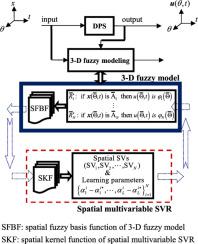European Journal of Control ( IF 2.5 ) Pub Date : 2019-11-27 , DOI: 10.1016/j.ejcon.2019.11.006 Xian-Xia Zhang , Han-Yu Yuan , Han-Xiong Li , Shi-Wei Ma

|
Many industrial processes have significant spatiotemporal dynamics and they are usually called distributed parameter systems (DPSs). Modeling such system is challenging due to its nonlinearity, time-varying dynamics, and spatiotemporal coupling. Using model reduction techniques, traditional DPS modeling methods usually reduce an infinite-dimensional system to a finite-dimensional system, which leads to unknown nonlinearity and unmodeled dynamics. The modeling method and the established model are hard to understand. Here, we propose a spatial multivariable support vector regression (SVR) based three-domain (3-D) fuzzy modeling method for complex nonlinear DPSs. The proposed 3-D modeling method integrates the time-space separation and time-space synthesis into a 3-D fuzzy model. Therefore, it does not require model reduction and owns the capability of linguistic interpretability. A spatial multivariable SVR with spatial kernel functions is proposed to deal with spatiotemporal data. The spatial fuzzy basis functions from a 3-D fuzzy model are spatial kernel functions for a spatial multivariable SVR, which satisfy Mercy theorem. Hence, the spatial multivariable SVR can be directly employed to build up a complete 3-D fuzzy rule-base of the 3-D fuzzy model. The proposed modeling method integrates the merits of learning ability from a spatial multivariable SVR and fuzzy space processing and fuzzy linguistic expression from a 3-D fuzzy model. The proposed 3-D fuzzy modeling method is successful applied to a simulated rapid thermal processing system. In comparison with several newly developed modeling methods for DPSs, the simulation results validate the superiority of the proposed modeling method.
中文翻译:

时空模糊建模的空间多变量SVR方法及其在快速热处理中的应用
许多工业过程具有显着的时空动力学,通常称为分布式参数系统(DPS)。由于其非线性,时变动力学和时空耦合,对这种系统进行建模具有挑战性。传统的DPS建模方法使用模型约简技术通常会将无穷维系统简化为有限维系统,从而导致未知的非线性和不可建模的动力学。建模方法和建立的模型很难理解。在此,我们针对复杂的非线性DPS,提出了一种基于空间多变量支持向量回归(SVR)的三域(3-D)模糊建模方法。所提出的3-D建模方法将时空分离和时空综合集成到3-D模糊模型中。因此,它不需要模型简化,并具有语言解释能力。提出了一种具有空间核函数的空间多变量SVR来处理时空数据。3-D模糊模型中的空间模糊基函数是用于空间多变量SVR的空间核函数,满足Mercy定理。因此,空间多变量SVR可直接用于构建3-D模糊模型的完整3-D模糊规则库。所提出的建模方法融合了空间多变量SVR和模糊空间处理的学习能力以及3-D模糊模型的模糊语言表达。所提出的3-D模糊建模方法已成功应用于模拟快速热处理系统。与DPS的几种最新开发的建模方法相比,











































 京公网安备 11010802027423号
京公网安备 11010802027423号